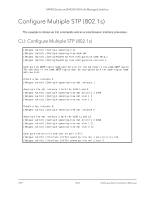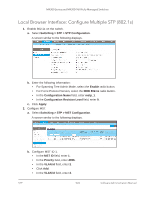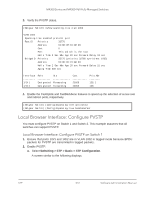Netgear XSM4324FS Software Administration Manual Software Version 12.x - Page 528
If a switch that runs PVRSTP receives PVSTP Bridge Protocol Data Units BPDUs,
 |
View all Netgear XSM4324FS manuals
Add to My Manuals
Save this manual to your list of manuals |
Page 528 highlights
M4300 Series and M4300-96X Fully Managed Switches Per VLAN Spanning Tree Protocol (PVSTP) is similar to the Spanning Tree Protocol (STP) as defined by IEEE 802.1d, but with one main difference: PVSTP runs one instance per VLAN. The protocol is equivalent to Cisco's PVST+ and can interoperate with it. If you enable PVSTP or PVRSTP on a switch, all other spanning tree modes on the switch become disabled. The difference between Multiple Spanning Tree Protocol (MSTP) and PVSTP or PVRSTP lies primarily in the way that the protocol maps spanning tree instances to VLANs: PVSTP or PVRSTP creates a spanning tree instance for each VLAN, whereas MSTP maps one or more VLANs to each Multiple Spanning Tree (MST) instance. If a switch that runs PVRSTP receives PVSTP Bridge Protocol Data Units (BPDUs), the switch falls back from PVRSTP to PVSTP after its migration-delay timer expires. A switch that runs PVSTP or PVRSTP transmits IEEE spanning tree BPDUs along with Shared Spanning Tree Protocol (SSTP) BPDUs. The SSTP BPDU are transmitted as untagged packets on an access or native VLAN and transmitted as tagged packets on other VLANs. If a switch that runs PVSTP or PVRSTP receives IEEE spanning tree BPDUs, the switch include them in an access VLAN instance or native VLAN instance. The Per VLAN Spanning Tree (PVST) behavior is as follows: • An access port sends IEEE spanning tree BPDUs. • A trunk port sends IEEE spanning tree BPDUs and SSTP BPDUs on the native VLAN. For other VLANs, the trunk port transmits SSTP BPDUs as tagged packets with the respective VLAN. If the trunk port receives IEEE spanning tree BPDUs, the received BPDUs are processed by the instance that is mapped to the native VLAN. The SSTP BPDUs are processed by instances to which the respective VLANs are mapped. If a switch that is running an IEEE standard spanning tree protocol (such as STP, RSTP, or MSTP) receives SSTP BPDUs, the switch does not treat them as standard BPDUs. Instead, the incoming SSTP BPDUs are flooded to all the ports of the corresponding VLAN. As a comparison, incoming STP BPDUs are multicasted over the region. A switch that runs an IEEE standard spanning tree protocol uses its Common and Internal Spanning Tree (CIST) to communicate with a switch that runs PVSTP or PVRSTP. On the other hand, a switch that runs PVSTP or PVRSTP uses an access VLAN instance or native VLAN instance to communicate with a switch that runs an IEEE standard spanning tree protocol. PVRSTP embeds support for the FastUplink feature to speed up the selection of a new root and the FastBackbone feature to speed up the selection of indirect ports. You do not need to configure these features for RVRSTP. However, for PVSTP, you need to configure these features: • FastUplink. This feature allows for a quick selection of a port with the lowest cost after the root port fails. That is, FastUplink reduces the converge time after a link fails. This feature is similar to Cisco's UplinkFast feature. If the primary link fails, FastUplink creates an alternate path immediately, speeding up the transition from the failed primary link to the backup link. • FastBackbone. This feature allows for faster convergence time when an indirect link to the root fails. If a root port or blocked port receives an inferior BPDU from the designated STP 528 Software Administration Manual















